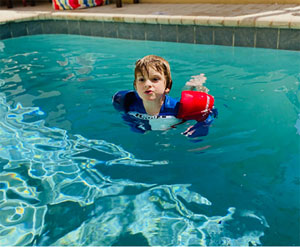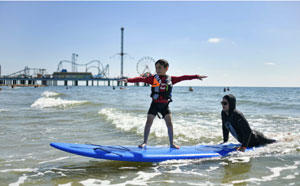 Summer for a neurotypical kid can be freeing, relaxing and adventure filled. However, for families with a child diagnosed with autism, life can be different. The lack of a regulated schedule can cause significant struggles over the summer break.
Summer for a neurotypical kid can be freeing, relaxing and adventure filled. However, for families with a child diagnosed with autism, life can be different. The lack of a regulated schedule can cause significant struggles over the summer break.
Hope For Three’s board member, Dr. Dana Walker, is a mother of an autistic child and the Fort Bend ISD Professional Educational Diagnostician. Her experience has led to many helpful tips for families with children with special needs.
“When children are not kept on their usual routine, negative behavior tends to increase,” said Walker. “Keeping to a consistent schedule, using your normal communication systems, and incorporating physical activity into the day can help parents and kids have a fun and successful summer.”
Hope For Three is a local nonprofit that assists families with children with autism by providing resources and financial support for programs, therapies, and educational pursuits. With the assistance of Dr. Walker, Hope For Three offers the following tips to provide structure in the summer while incorporating fun.

Rhett Smith, age 7, swims year-round. Swimming channels his autism energy and boosts his confidence.
Create a summer schedule: If a child isn’t going to an extended school year program or summer structural program, plan for consistency throughout the ‘school day’ by keeping similar schedules for waking up, meals and bedtimes.
Add community-based instructions into learning: Use summertime to teach and practice familiar routines, such as grocery shopping. Incorporate seasonal cooking foods into the lesson plan to expand knowledge of fruits and vegetables and to try something new.
Keep the same house rules all summer: Rules shouldn’t change for summer break. Consistency is essential, and communicating rules and expectations are vital. Continue to use your preferred communication method, too, if it’s PECS, sign language, or verbal communication; keep it up to a avoid a breakdown in skills and use positive enforcement to affirm behaviors.

Nico Laine, age 9, is onboard with his surfing techniques, compliments of Waves of Impact, a nonprofit group connecting extraordinary families and individuals to the community around them through surfing.
Swim Safety: Children with autism are 160 times as likely to drown as the general population. Swim safety is paramount during the summer when many activities occur near or around a pool. Look into swim classes to have fun while being safe.
Introduce new places or activities: If your child is attending a camp or summer program, introduce the place or activities in advance. Take this time off to introduce new places you can’t usually go to during the school year.
Take small steps and allow for extra time: Plan out your days in advance and plan in your spare time to prepare for the activity and the setbacks that come with trying something new. Take small steps, and don’t plan too much in one day. A trip to the grocery store alone might fill up all the time you need in your schedule.
“Parents are not always with their kids all summer. I highly recommend parents identify locations that provide respite care and take those opportunities to rest,” said Walker. “You can even check with your insurance provider on what might be available and covered. Plus, check out Hope For Three programs like Teen Huddle or Let’s Get Together to spend time with people in similar situations.”
Hope For Three is a local 501c3 nonprofit and autism advocacy group providing resources and support to families living with an autism spectrum disorder. The organization also generates awareness through outreach, education and events. To learn more about Hope For Three, visit www.hopeforthree.org.